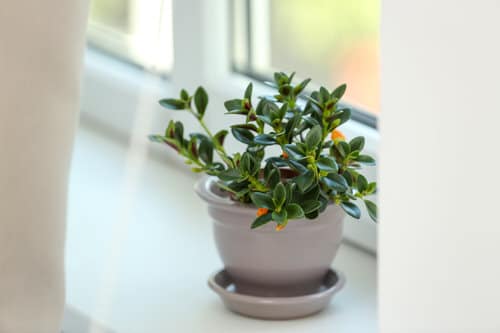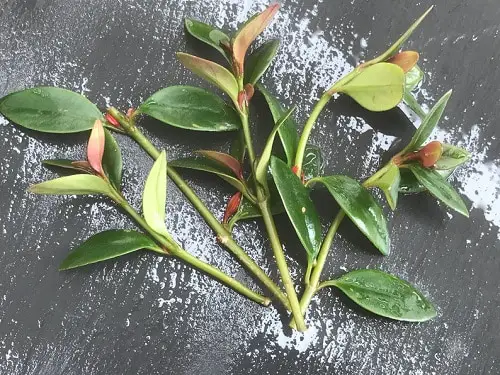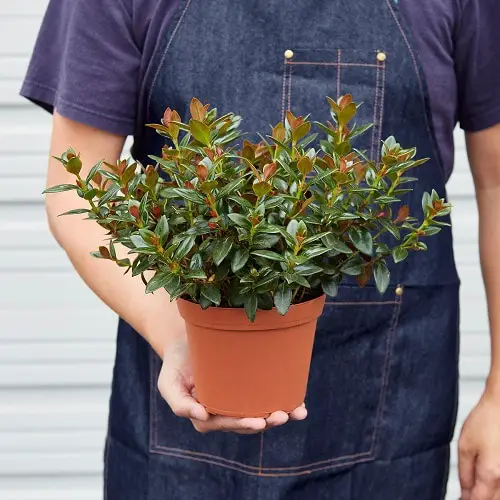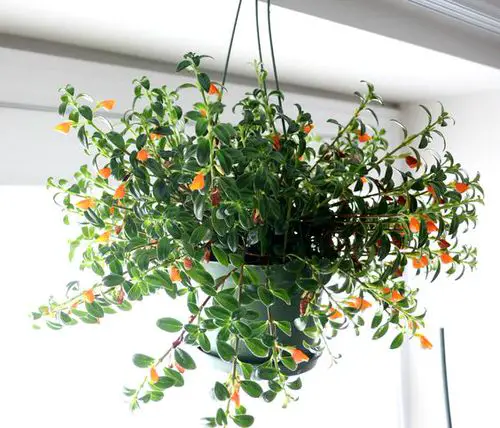The stunning Clog Plant is a fantastic sight to see in any home with its bright orange blooms. Here are all the details on Goldfish Plant Care Indoors!

Clog Plant adorns itself with brilliant red-orange flowers reminiscent of a leaping goldfish. Best kept in a hanging basket or pot in a way that the plant spill around from all sides, putting on a fabulous show! It lives long when given proper care and thrives in regular home conditions. To understand more, here’s a detailed guide on Goldfish Plant Care Indoors!
Botanical Name: Nematanthus gregarius
Other Names: Guppy plant, Column Flower, Candy Corn Plant, Clog Plant
Check out our article on spider plant care indoors here
Goldfish Plant Propagation

The best way to propagate a Goldfish plant is with stem cuttings:
- Use a sharp shear and cut a 3-5 inches stem with no flowers.
- Dip the end in a rooting hormone.
- Place the cutting in a well-draining soil mix.
- Water well and keep the pot where it gets bright, indirect light.
Nematanthus Native Habitat
To grow this plant well, you’ll have to understand this exotic plant’s origin–it grows in South America, particularly in tropical rainforests of Brazil. It is epiphytic in nature and grows in the canopy of trees. Growing it is somewhat similar to houseplants like Christmas cactus.
Growing Requirements of Goldfish Plant

Light
An East-facing window or somewhere where gentle morning sunlight is present is ideal for the plant as it will help it to grow well with many flowers! Ensure that it gets 2-4 hours of mild direct sunlight or bright indirect light all day. Avoid keeping the plant in full sun!
Soil
You can any soil mix, but it should be loamy and well-draining. This will prevent the chances of root rot or other diseases. Avoid using compact garden soil.
Water
For a plant like this, you’ll have to water it regularly to keep the soil slightly moist. However, don’t water frequently or too much to avoid overwatering. Check the topsoil with fingers and water when it feels a bit dry to the touch.
Temperature and Humidity
Many think that tropical plants need warmth. Nevertheless, in the forests, these plants are shaded by a canopy of trees. Therefore, the temperature is much lower than expected!
They need a temperature of 60-80 F (15-28 C) and a humid environment. Use a humidifier or mist once in a while so the humidity levels around the plant stay stable. Always use room temperature water to mist, as cold water can shock the plants.
Goldfish Plant Care Indoors

Fertilization
Use a balanced or high phosphate, water-soluble fertilizer, diluted to 1/4 of its strength, once in 3-5 weeks. You can also mist the foliage with the solution of half teaspoon balanced water-soluble fertilizer in a gallon of water once a month in the growing period.
Repotting
The plant prefers to be slightly root-bound, so re-pot it once every 2-3 years. While repotting, make sure you snip away the damaged roots. Also, remember to choose a pot size that is just one size bigger than the previous one.
Pests and Diseases
These plants are highly susceptible to botrytis mold, fungal leaf spots, and mosaic viruses. Aphids, spider mites, and cushion scales are very common among these species. A regular check-up on the leaves and stems is a must. If an infestation is there, use Neem or Tree tea oil swabs around the leaves and stems.
Does a Goldfish Plant Bloom?

Yes! The plant is quite famous for its bright red and orange flowers that grow in spring and summer, contrasting beautifully with its dark green foliage. The blooms look like a leaping goldfish, hence the name!
How to Get a Goldfish Plant to Bloom?
The best way to encourage the plant to have more blooms is to place it at a location where it gets a bright light exposure. Keeping it near an east-facing window, where it can bask in the direct morning sun for 3-4 hours, will be a great idea. It promotes flowering while saving the plant from becoming leggy, and if it becomes leggy, the best trick to rejuvenate the growth is: prune its top tips!
Is Goldfish Plant Toxic to Cats and Dogs?
According to the American Society for the Prevention of Cruelty to Animals, the plant is completely safe for dogs and cats. You can keep it in your house without worrying about your pets.


